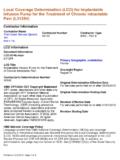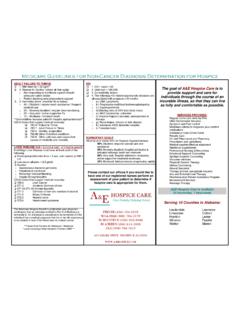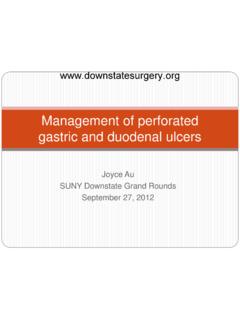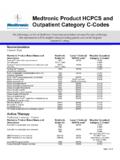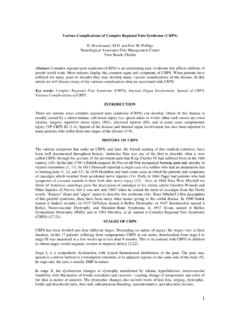Transcription of Sesamoid Disorders of the First …
1 1. 2 S e s a m o i d Di s o rd e r s 3. 4 of the First 5. 6 metatarsophalangeal 7. 8 Joint 9. 10. 11 Allan Boike, DPM, Molly Schnirring-Judge, DPM*, 12 Sean McMillin, DPM Q2 Q3. 13 Q4 Q5. 14. 15 KEYWORDS. 16 Sesamoids Feet First metatarsophalangeal joint 17 Disorders Q6. 18. 19. 20. 21 The sesamoids of the feet were named by Galen circa 180 CE because of their resem- 22 blance to sesame seeds. These tiny bones were believed by the ancient Hebrews to 23 be indestructible and therefore the housing for the soul after death, which would 24 ultimately be resurrected on the Day of However, the Sesamoid complex, 25 which transmits 50% of body weight and more than 300% during push-off, is not 26 invincible and is susceptible to numerous ,3 These pathologies include 27 sesamoiditis, stress fracture, avascular necrosis, osteochondral fractures, and 28 chondromalacia, and are secondary to these large weight-bearing loads.
2 This article 29 discusses Sesamoid conditions and their relationship with hallux limitus, and reviews 30 the conditions that predispose the First metatarsophalangeal joint (MPJ) to osteoar- 31 thritic changes. 32 There is much debate regarding the causes of hallux limitus and rigidus and the role 33 of the sesamoids in precipitating the decreased range of motion of the First MPJ has 34 been considered in some detail. Typically, little is done to the sesamoids at the time of 35 surgical treatment of the hallux limitus deformity. This article reviews the recent 36 literature of Sesamoid Disorders and, more specifically, their role in hallux limitus. 37 Potential treatment options are also discussed. 38. ANATOMY Q7. 39. 40 The sesamoids are located centrally and plantar to the First metatarsal head where 41 they are imbedded within the plantar plate.
3 There are 3 sesamoids associated with 42 the great toe joint; 2 are considered constant and lie beneath the First metatarsal 43 head, and the third, referred to as inconstant, when present develops inferior to the 44 hallux interphalangeal joint (HIPJ). These bones may be semiovoid, bean shaped, or 45. 46. 47 * Corresponding author. 48 E-mail address: Clin Podiatr Med Surg - (2011) - - 0891-8422/11/$ see front matter 2011 Published by Elsevier Inc. CPM496_proof 11 April 2011 5:41 pm 2 Boike et al 49 circular and so are considered variable in morphology. The 2 sesamoids of the First 50 MPJ are not typically equal in size. The tibial Sesamoid is larger, ovoid, and elongated, Q8. 51 and is encased within the medial head of the flexor hallucis brevis (FHB) tendon. The 52 smaller fibular Sesamoid is smaller and more circular and is surrounded by the lateral 53 head of the FHB tendon.
4 The larger size of the tibial Sesamoid bears more weight than 54 the fibular Sesamoid and is believed to predispose the medial Sesamoid to more disor- 55 ders. Portions of the adductor and abductor hallucis tendons also insert on the sesa- 56 moids. The sesamoids are suspended by a medial and lateral sesamoidal ligament 57 that extends from the metatarsal head and inserts on the medial portion of the tibial 58 Sesamoid and lateral portion of the fibular Sesamoid . This ligamentous stirrup-type 59 arrangement about the Sesamoid apparatus contributes to the plantar plate of the First 60 MPJ; a structure understood to be vital to the gliding function of the joint. Further 61 ligamentous attachments include the deep transverse intermetatarsal ligament 62 extending from the fibular Sesamoid to the neck of the second metatarsal as well as 63 an intersesamoidal ligament that serves as an attachment between the 2 sesamoids 64 and again forms part of the plantar ,2,4,5.
5 65 The function of the sesamoids is to absorb and disperse weight bearing from the 66 metatarsal head. This function in turn provides protection to the flexor hallucis longus 67 (FHL) ,6 The sesamoids serve to increase the moment arm of the flexors, 68 increasing their power and supplementing the mechanical advantage of First MPJ. 69 motion. The sesamoids are invested within the FHB tendons and function to absorb 70 shock and enhance the gliding function of the 71 The arterial supply to the sesamoids is important for Sesamoid injury, healing, and 72 potential surgical outcomes. Each Sesamoid has been shown to receive its own indi- 73 vidual artery for nutrition, but may have 2 or 3. Blood supply stems from the medial 74 plantar artery (25%), the plantar arch (25%), or from both sources (50%).
6 2,4 Both sesa- 75 moids receive blood supply from proximal and plantar sources, but are less vascular- 76 ized distally. The proximal supply enters through the FHB insertion, and plantarly via 77 midline capsular attachments. The more sparse distal supply comes from the capsule 78 and may help explain some Disorders such as osteonecrosis or nonunion of fractures 79 (Fig. 1).1,2 Because of the predominately plantar vascular supply, incisional 80 approaches are safer from the dorsum or medial 81 Ossification of the sesamoids occurs between the ages of 7 and 10 years, beginning 82 usually with the fibular Sesamoid followed by the tibial Agenesis or 83 congenital absence of the sesamoids is rare. There are typically multiple ossification 84 centers, which may result in bipartite sesamoids caused by incomplete fusion of these 85 2 centers.
7 The tibial Sesamoid is bipartite in approximately 10% of the population 86 (Fig. 2), whereas the fibular Sesamoid is rarely bipartite. In patients who have a bipartite Q9. 87 tibial Sesamoid , 25% have the bilateral ,4 Weil and Hill7 reported a statisti- 88 cally significant correlation between the incidence of a bipartite tibial Sesamoid and 89 hallux valgus deformity, hypothesizing that the bipartite tibial Sesamoid causes an 90 imbalance in the intrinsic musculature. 91. 92. CLINICAL FINDINGS. 93. 94 Sesamoid Disorders account for 9% of foot and ankle injuries and of running 95 Although any patient can suffer from various forms of Sesamoid disorder, 96 chronic Sesamoid afflictions may occur more frequently in active patient populations. 97 The pain associated with Sesamoid Disorders is variable and can range from joint 98 pain or capsulitis of the First MPJ to pain localized to the affected Sesamoid or the 99 Sesamoid apparatus plantarly.
8 The pain may be constant or simply aggravated by CPM496_proof 11 April 2011 5:41 pm Sesamoid Disorders Q1 3. 100. 101. 102. 103. 104. 105. 106. 107. 108. 109. 110. 111. 112. 113. 114. 115. 116. 117. 118. 119. 120. 121. 122. 123. 124. 125. 126. 127. 128. 129. 130. 131. 132. 133 Fig. 1. Avascular necrosis of the tibial Sesamoid as a result of an aggressive debridement of 134 the medial eminence to reduce a bunion deformity. Note the sclerotic appearance of the 135 Sesamoid bone and the irregular residual medial border of the metatarsal head and neck as evidence of an aggressive eminence resection. The vascular supply to the sesamoids is 136. at risk whenever surgical intervention for reduction of the bunion deformity is pursued. 137. 138. 139 weight-bearing activity. A chief complaint of pain around the big toe or the sensation 140 of a snapping about the joint after running can be the harbinger of Sesamoid disor- 141 ders.
9 Generally, pain is expressed during the final stage of stance phase when the 142 hallux is extended. Trauma or an increase in activity may precede an acute fracture 143 or stress fracture. Burning, radiating, or pins-and-needles pain may indicate neuritis 144 incited by edema, inflammation, or by a displaced The differential diag- 145 nosis associated with Sesamoid Disorders includes, but is not limited to, acute frac- 146 ture, osteochondritis, repetitive stress injury, osteoarthritis (also called sesamoiditis 147 [Fig. 3]), infection, nerve impingement, and intractable plantar 148 The physical examination often reveals pain with end range of motion of the First 149 MPJ with dorsiflexion. Evidence of edema, loss of active and passive dorsiflexion, 150 and weakness with plantar flexion may be associated with Sesamoid Disorders .
10 Direct CPM496_proof 11 April 2011 5:41 pm 4 Boike et al 151. 152. 153. 154. 155. 156. 157. 158. 159. 160. 161. 162. 163. 164. 165 Fig. 2. (A) Bipartite tibial Sesamoid on plain film dorsal plantar projection. Associated here 166 with a short First ray segment and functional hallux limitus, it is easy to appreciate that the 167 tibial Sesamoid is in 2 pieces with a well-circumscribed erosion within its most proximal 168 lateral pole. The distal pole appears almost crescent in shape. (B) The bifid appearance 169 can be elucidated from this view; however, given the overlap with the fibular Sesamoid , 170 the dorsal plantar view remains the optimal projection to assess this morphology. 171. palpation plantarly and translocating the sesamoids distally usually elicits pain as well. 172.
